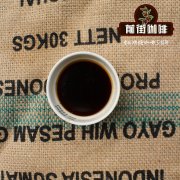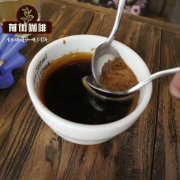Resting treatment of San Pedro production area in Yauco Town, Yuco, Puerto Rico | the wind of washing beans with AA

Professional coffee knowledge exchange more coffee bean information please follow the coffee workshop (Wechat official account cafe_style)
Resting treatment of San Pedro production area in Yauco Town, Yuco, Puerto Rico | what is the flavor and cooking of AA washed beans?
Puerto Rico is an autonomous territory of the United States in the Caribbean, with San Juan as its capital. In Spanish, Puerto Rico means "port of wealth". The history of coffee in Puerto Rico dates back to 1736, when coffee saplings were brought into the country by early Spanish immigrants. In the 18th century, coffee was ignored because the main economic crop was sugar cane. At the beginning of the nineteenth century, the French began to emigrate from the Mediterranean island of Corsica to Puerto Rico because of European politics. Excluded by the Spaniards, many French settled in Yuko Yauco in the southwest.
Yuko's geographical environment is more hilly, so the French decided to grow coffee. After working hard for half a century, the quality has been affirmed by the market, which has established the position of Yauco Selecto coffee in the market in the future. Coffee in this country is carefully grown, and the best coffee is Yauco Selecto, which means "Selecto". Yukot Coffee is grown only on three farms in the southwest of the island (San Pedro, Caracolillo and La Juanita). It has a strong flavor and a long aftertaste, and its flavor is comparable to that of other excellent coffee varieties in the world.
The mountain climate here is mild, the plants have a long mature period (from October to February), and the soil is high-quality clay. People here have been using an eco-friendly, intensive planting method, picking only fully ripe coffee beans and then washing them in a roller device for 48 hours. Yukot selects coffee beans that are kept in shells before they are shipped, and the skins are not removed until the order is shipped to ensure the freshness of the coffee. Relevant U.S. government employees, such as FDA and USEA, will also be present when the goods are submitted, and they work to monitor producers' compliance with federal regulations. There are also practitioners from local evaluation boards who take 1 bag out of every 50 bags as samples and use international gauges to evaluate their quality.
Yukot chose Yauco Selecto AA, dried raw beans (and parchment) and stored them as resting for export for 60 days, and of course the taste will be more ripe-this time there are high-quality beans along with Nicaraguan Monimbo Manor beans, PNG Sigri AA and the rare Sigri PB that became the highlight of the country's coffee competition in 2002 (remember when I got the PB sample in Seattle? ) these beans will be put on the shelves after cup testing.
The main coffee producing areas in the Caribbean were hit by a number of hurricanes in 2004, so the coffee harvest was affected, resulting in a shortage of goods. Yukot chose less than 15 containers a year, so this year's raw beans can find some defective beans. According to Yuke, which just arrived on June 1st, although it is AA, there is about one defect in the inspection results of 350g raw beans. This year's Seattle SCAA Show There are not as many national exhibitors in this area as in previous years, which is also the result of the hurricane. And this batch of raw beans of Yuke are not boubon species, but Porto Rico varieties species, and their appearance is quite similar to the traditional typica species. If you have Yukot beans selected in previous years, you might as well compare them with each other. The appearance of raw beans will be obviously different, while the cup test is still typical [Yuke style].
Cup test:
Producing area: the town of Yauco, Puerto Rico (the mountains of southwest Puerto Rico)
Manor: San Pedro, Santa Ana
Grade: AA
Variety: Porto Rico varieties (no new commercial varieties are adopted)
Treatment: washing method
Dry aroma: oil, drupe, sweet spice, with hints of flowers and vanilla
Wet fragrance: sweet milk, tea, stone fruit, citrus sweet, caramel sweet
Sipping: sweet cocoa, sticky body grease, long-lasting sweet caramel aromas of citrus and other fruits
Cup test (2): medium baking
Dry fragrance: sweet nuts, sweet fruit, sweet spices, greasy flavor, mint cool fragrance
Wet fragrance: sweet cream, sweet cocoa nuts, a little scented tea, spicy sweet
Sipping flavor: body creamy oily taste, citrus ripe sweet and sour taste, cocoa chocolate flavor, long-lasting nose aroma
Yauco Selecto AA is a high-quality coffee located in Puerto Rico. It is a famous island bean, on a par with Hawaiian Cona beans and Caribbean beans.
Puerto Rico means "port of abundance". Coffee has been introduced to Puerto Rico for more than 250 years. Spain began to colonize and grow coffee in 1736. By the 19th century, coffee had become the second industry on the island. In the early 19th century, immigrants from the French island of Corsica were forced to farm in the high mountains of the southwest and decided that coffee was the main crop; the arable land was mainly around a town called Yauco. In 1860, there were two major events that established Yukot's position in bean selection.
The first thing: the Mariani family, for the first time, used the cotton gin machine to screen the cotton fiber to remove the shell of the coffee fruit, which had a revolutionary impact.
Second, the leader of Corsica growers, who financially supported the beans in the region, shipped them back to Europe's main coffee trading center and recommended them to buyers, which quickly received a wide response. Their hard work finally came at a price.
In the 1860s, Puertorrican coffee, especially from the Yauco region, won the reputation of premium coffee, and emperors and queens all over Europe were regarded as the best coffee! High society and widely drunk! Coffee-producing countries are also scrambling to emulate Puerto Rico's planting method. At that time, the production of this island ranked sixth in the world! (in other words, in Europe, gluttons started tasting boutique coffee a hundred years ago.)
Two devastating hurricanes hit Puerto Rico in 1898. The hurricane damaged the coffee industry and the war between the United States and Spain began in the same year, after the war with the Philippines and Cuba. Once again, the US government is only more interested in the sugar industry (like Spain at that time). The double whammy is that European countries no longer regard Puerto Rican coffee as a colonial product. Fortunately, in the first half of the 20th century, Cuba, an emerging market, bought most Puerto Rican coffee, but Yukot continued to sell to Europe to supply some glutton.
In 1917, Puerto Rico islanders became American citizens, which means that people enjoy a minimum wage and that coffee is as expensive to grow as Kona in Hawaii. The labor cost in Puerto Rico must meet the standards of the United States government and the environment in which coffee is grown, as well as the environmental protection policy of the United States, which actually increases the production cost in Puerto Rico! Under the high cost structure, the factors supporting the coffee industry in Puerto Rico are:
(1) because this island produces high-quality coffee! Under a free economy, if the quality is poor and uncompetitive, the local market can buy imported coffee, and it is even more difficult for the poor quality to be exported to other countries.
(2) the protection and care of the government, as there are traditional and high-quality crops, the government policy also encourages and assists the continuous cultivation of coffee.
(3) with the support of the residents of the island, due to the increase in national income and the developed tourism industry, all the coffee produced on the island was sold domestically during the 25 years from 1965 to 1990.
The reason why Yukot chooses beans better than other producing areas on the island is that:
1. it is planted in the highest mountain area of the island, so it grows slowly and the fruit is rich in flavor.
2, only using bourbon and the old species of the island, although the yield is less, but in the Yauco mountains, the flavor of the old species will not have the disadvantage of poor flavor as the new commercial species.
3, abundant rainfall, rich soil and located in the best high-altitude microclimate area of the island
4. The two manors are self-made in the whole process from planting coffee seedlings to post-harvest treatment, and the quality control is very strict.
Yukot selection has the characteristics of complete flavor, fragrant taste, distinct layers, delicate sweetness and longevity, showing the characteristics of boutique coffee and an aftertaste. The annual output is low, so it is a must-taste coffee for coffee glutton.
Product name: Yuke Special Puerto Rico Yauco Selecto AA, Puerto Rico
Origin: Puerto Rico
Raw bean treatment: washing
Qianjie recommended cooking:
Filter cup: Hario V60
Water temperature: 90 degrees
Degree of grinding: small Fuji 3.5
Cooking methods: the ratio of water to powder is 1:15, 15g powder, the first injection of 25g water, 25 s steaming, the second injection to 120g water cut off, waiting for the powder bed water to half and then water injection, slow water injection until 225g water, extraction time about 2:00
Analysis: using three-stage brewing to clarify the flavor of the front, middle and back of the coffee. Because V60 has many ribs and the drainage speed is fast, it can prolong the extraction time when the water is cut off.
Important Notice :
前街咖啡 FrontStreet Coffee has moved to new addredd:
FrontStreet Coffee Address: 315,Donghua East Road,GuangZhou
Tel:020 38364473
- Prev

Panamanian Erida Manor Rose Summer Coffee introduction Front Street Erida Manor tin card hand flushing suggestion
Professional coffee knowledge exchange more coffee bean information Please pay attention to the coffee workshop (Wechat official account cafe_style) the manor planting environment has several characteristics: shade planting (shade-grown), great emphasis on conservation and bird-friendly environment (bird friendly), water washing with low water consumption greatly reduces the impact on the environment (low water ues for post-proce)
- Next

How about Hawaiian coffee? What are the characteristics of Hawaiian coffee? Suitable for roasting degree of Hawaiian coffee
Professional coffee knowledge exchange more coffee bean information Please follow the coffee workshop (Wechat official account cafe_style) people are always looking for the best things, looking for the most mellow wine, the most charming cigars or the noblest champagne, etc., and coffee is the same, it is happy to drink good coffee, so people begin to pursue better coffee, from
Related
- Detailed explanation of Jadeite planting Land in Panamanian Jadeite Manor introduction to the grading system of Jadeite competitive bidding, Red bid, Green bid and Rose Summer
- Story of Coffee planting in Brenka region of Costa Rica Stonehenge Manor anaerobic heavy honey treatment of flavor mouth
- What's on the barrel of Blue Mountain Coffee beans?
- Can American coffee also pull flowers? How to use hot American style to pull out a good-looking pattern?
- Can you make a cold extract with coffee beans? What is the right proportion for cold-extracted coffee formula?
- Indonesian PWN Gold Mandrine Coffee Origin Features Flavor How to Chong? Mandolin coffee is American.
- A brief introduction to the flavor characteristics of Brazilian yellow bourbon coffee beans
- What is the effect of different water quality on the flavor of cold-extracted coffee? What kind of water is best for brewing coffee?
- Why do you think of Rose Summer whenever you mention Panamanian coffee?
- Introduction to the characteristics of authentic blue mountain coffee bean producing areas? What is the CIB Coffee Authority in Jamaica?

